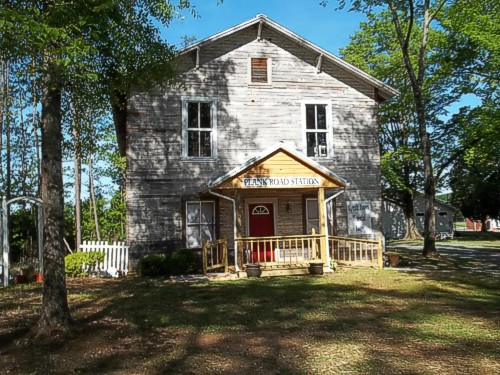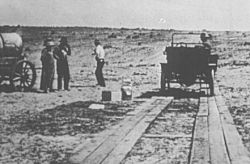
Can you imagine traveling on plank roads between cities in Alabama?
There were several plank roads in Alabama before the advent of the railroad. They have disappeared now.
A plank road is a dirt path or road covered with a series of planks, similar to the wooden sidewalks one would see in a Western movie. Wagon roads surfaced with plank, kept the road open for traffic during the entire year which otherwise would be impassable during wet weather.
Plank roads are similar to corduroy roads.
A corduroy road or log road is a type of road made by placing sand-covered logs perpendicular to the direction of the road over a low or swampy area. The result is an improvement over impassable mud or dirt roads, yet rough in the best of conditions and a hazard to horses due to shifting loose logs.

Building of Plank Roads
The first plank roads in this country were built in the State of New York in 1846 in Syracuse to transport salt and other goods. This coincided with the culmination in Alabama of the state-wide agitation for cheap and convenient channels of commercial intercourse, in a multitude of schemes and projects for canals, railroads, and wagon roads of various sorts-some of them practicable, but more of them altogether visionary.
Cheap and Easy to Build
The sponsors for the plank road system emphasized their immediate availability, because of their comparative cheapness and ease of construction. The people of the State felt that Alabama had lagged behind the rest of the country in such improvements and were in a receptive attitude toward any plan which promised quick attainment of the advantages of ready communication and interchange of products. It required little argument to convince many of the most influential men of the State that the construction of extensive systems of plank roads offered the readiest solution of the transportation problem in Alabama.
The first plank road was introduced in Alabama in 1849. Easily built in a region where virgin timber was plentiful, it consisted of parallel rows of squared oak "sleepers" covered with timbers eight feet long and three inches thick.
Govenor H. W. Collier was one of the early converts to this theory, and he placed himself on record in the following language: "The opinion prevails extensively that plank roads are quite as well adapted to our wants as any other mode of intercommunication, and being less costly, may be made in those parts of the State where they are most needed by associations of individual enterprise, and capital. In New York (and perhaps some other States), a general plank road law has been enacted. I respectfully recommend, with the view of encouraging such improvement, that a similar act be passed by the General Assembly, prescribing the manner in which such corporations may be formed, their powers, &c., so as to render it unnecessary to apply to the Legislature for a specific charter. This enactment would prevent delay, by permitting individuals to associate and commence work whenever they were prepared for it."
Apparently it was not Gov. Collier's belief that plank roads would fill the place of railroads or even seriously compete with them. It was their feasibility under wretched local conditions that impressed him-their cheapness and facility of construction. The prevalent idea was to adopt the readiest means at hand for connecting the plantations with the towns, and plank roads seemed to offer the means.
Plank Roads were Easy to Maintain
Some enthusiastic engineers undertook to demonstrate by elaborate series of arguments and tables of figures, not only that plank roads could be more cheaply and expeditiously built than railroads or macadamized highways, but that they could be maintained at much less expense, and, consequently, would be a more profitable investment for capital.
They asserted that freight could be hauled over them by wagons at the same price per ton that railroads would have to charge, and, by the use of relays of horses, almost as quickly. Another advantage, they claimed, was the fact that the road itself represented the entire investment, an expensive equipment of motive power, rolling stock, depots, repair shops and machinery, and the requisite employees to operate and care for them, not being necessary as in the case of railroads, for the patrons of plank roads would furnish the motive power and rolling stock in the shape of their own wagons and teams. These and numerous other arguments persuaded many persons that plank roads represented a more real and immediate public need than railroads.
However, warping in winter and attacks of boring insects and dry rot in summer made created expensive repairs.
First Plank Roads in Alabama
The first plank road company in Alabama chartered was the "Cane Brake Plank Road Company," which projected a road from Demopolis to Uniontown. and was incorporated by the legislature, March 4, 1848.
On February 12, 1850, a general act providing for the incorporation of companies to construct macadamized, graded, turnpike, wooden, rail roads, or plank roads was approved, and during the same session- 1849-50-24 separate companies were chartered. During the session, 1851-52, 10 new companies were incorporated, and 5 or 6 acts authorizing existing companies to borrow money were passed. During the session of 1853-54 only 1 new charter was issued, making 35 in all during a period of slightly over 5 years.
No Record of Exact Number of Miles of Plank Roads in Alabama
There are no available records to show the exact number of miles constructed, but several such roads were either wholly or partly built and used as toll roads for varying lengths of time. Among those best known were the Montgomery South Plank Road, of which 17 miles, between Montgomery and Steep Creek in Lowndes County, were completed; the Central Plank Road, projected between Montgomery and Guntersville via Wetumpka and Talladega, of which about 60 miles north of Wetumpka were put in service; the Tuscaloosa and Greensboro Plank Road, all or most of which was completed and used for several years.
The Central Plank road began at Montgomery and kept mainly along the Judkins Ferry Road, crossing the Tallapoosa River at the ferry. It reached the hills and kept the river lands at the foot of the hills, and came into the public road near Harrowgate Springs, and from there into Wetumpka. It passed through the business part of town and then kept to the edges of the hills running in front of the penitentiary, and then though Central. it by-passed Nixburg as the people of Nixburg had, in some ways, irritated the John G. Winter, a banker of Columbus, Georgia who was the president of Plank Road Company. It came into Sylacauga and from thence to Talladega.
Saw Mills Moved with the Road Building
Saw mills were erected along the way to cut timbers for the road building. The saw mills were moved along the road building.
These were toll roads, capitalized at $50,000 each, there was a charge of 2 1/2 cents a mile for a four house private pleasure carriage; a loaded wagon with two horses was 3 cents per mile. Also there were bridges that charged tolls. However, there were no charges for funerals or for people going to church, to mill, to a blacksmith, or to a doctor. There were besides several shorter stretches of planked road constructed in different localities over the State, aggregating, with the above mentioned, probably 150 miles.
The public welcomed the plank roads at first. A large barbecue was held at Sylacauga, "a distance of 70 miles from Montgomery, a large barbecue was planned there and everybody was invited. The Company wanted to show the people an improved road. The speaker for the day was William L. Yancey. Relays of horses and buggies had been provided for Mr Yancey's trip. The horses were not to be driven consecutively orver 6 or 7 miles; and at the end of this distance horses were kept harnessed ready for the change. Mr Yancey started at sun up, reached Sylacauga, stayed 2 hours for the speaking and dinner, and returned to Montgomery at sunset, making the 140 miles with a stop of only two hours between suns."
Interest in Plank Roads Lasted about Five Years
The enthusiasm for plank roads was comparatively short-lived, lasting only about five years. This was due partly to the overshadowing interest in railroads which arose among capitalists almost simultaneously, and partly to the great disparity between the estimated and the actual cost of their construction and maintenance.
Where maximum estimates of the cost of construction made by engineers in 1849 had been $1,200 to $1,500 per mile, the actual average cost by 1852 had been found to vary from $2,000 to $4,000 per mile, and even more where there were long stretches to be built through marshy or swampy country, and the cost of maintenance in proportion. The plank roads that were thus built were used for a time, but soon became merely relics of one of the sporadic phases of the development of transportation in Alabama.
Reference: www.alabamapioneers.com
